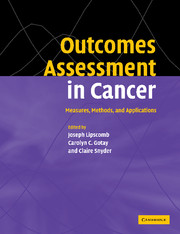Book contents
- Frontmatter
- Contents
- List of contributors
- Acknowledgments
- 1 Introduction to Outcomes Assessment in Cancer
- Health-related quality of life in cancer: general concepts and generic measures
- Assessing health-related quality of life during treatment
- Assessing health-related quality of life across the cancer continuum
- Measuring the experience and needs of cancer patients and caregivers
- 13 Patient advocate perspective on health-related quality of life issues with prostate cancer survivors
- 14 Measuring the patient's perspective on the interpersonal aspects of cancer care
- 15 Needs assessment in cancer
- 16 Assessing the subjective impact of caregiving on informal caregivers of cancer patients
- Methodological considerations in applications to cancer outcomes research
- Modern psychometric theory in cancer outcomes research
- Assessing the economic impact of cancer
- Research and policy implications
- Invited papers
- Index
- References
15 - Needs assessment in cancer
Published online by Cambridge University Press: 18 December 2009
- Frontmatter
- Contents
- List of contributors
- Acknowledgments
- 1 Introduction to Outcomes Assessment in Cancer
- Health-related quality of life in cancer: general concepts and generic measures
- Assessing health-related quality of life during treatment
- Assessing health-related quality of life across the cancer continuum
- Measuring the experience and needs of cancer patients and caregivers
- 13 Patient advocate perspective on health-related quality of life issues with prostate cancer survivors
- 14 Measuring the patient's perspective on the interpersonal aspects of cancer care
- 15 Needs assessment in cancer
- 16 Assessing the subjective impact of caregiving on informal caregivers of cancer patients
- Methodological considerations in applications to cancer outcomes research
- Modern psychometric theory in cancer outcomes research
- Assessing the economic impact of cancer
- Research and policy implications
- Invited papers
- Index
- References
Summary
Introduction
The needs of a person facing a serious illness such as cancer are very complex. Maslow argues that human needs arrange themselves in “hierarchies of pre-potency” such that the appearance of one depends upon prior satisfaction of more pre-potent needs. The most pre-potent of Maslow's needs are the physiological (e.g., maintaining homeostasis of oxygen, water). When these are not satisfied, as may be the case in a terminal cancer patient, no other needs are important. As long as those needs are satisfied, a patient or family member may be concerned about higher order needs such as the “safety” needs for predictability and orderliness that underlie the fear of the unknown often faced by newly diagnosed cancer patients. As long as these needs are met, one can hope that providers (as well as family and friends) will satisfy needs for affection and caring. And if these needs are met, one can seek to satisfy “esteem” needs such as the need for respect sought by many health care consumers today. Thus needs change as a patient's condition changes.
What are needs?
As discussed in Langley et al., Kano suggests that needs fall into three categories: expected, desired, and unexpected. And different types of needs have different effects on satisfaction. For instance, most patients and family members expect that they will be given the proper medication. Avoiding medication errors will not improve satisfaction, but making errors could devastate satisfaction.
- Type
- Chapter
- Information
- Outcomes Assessment in CancerMeasures, Methods and Applications, pp. 305 - 328Publisher: Cambridge University PressPrint publication year: 2004
References
- 2
- Cited by



